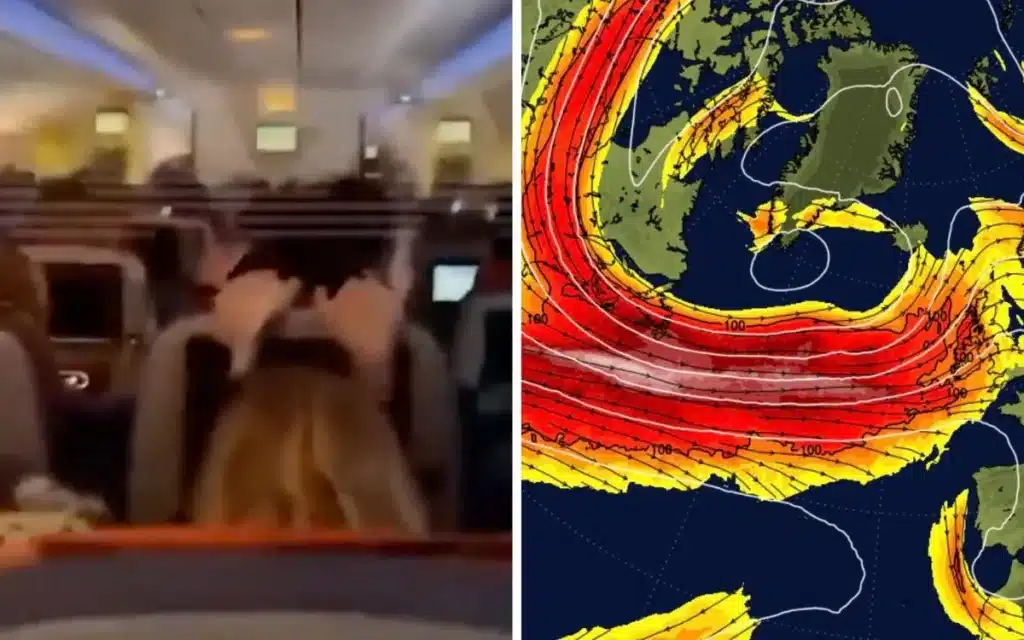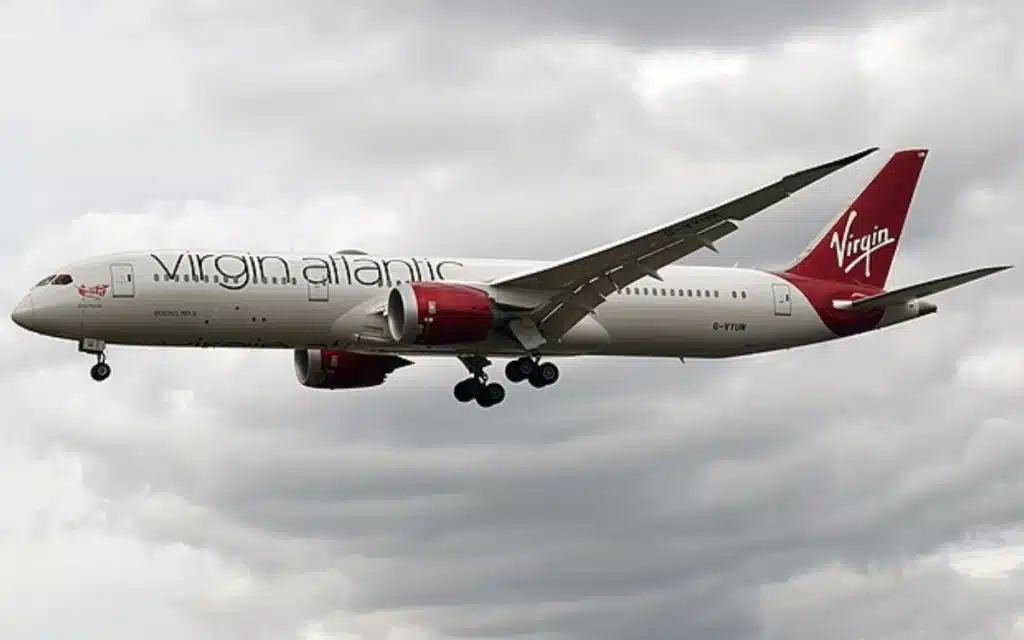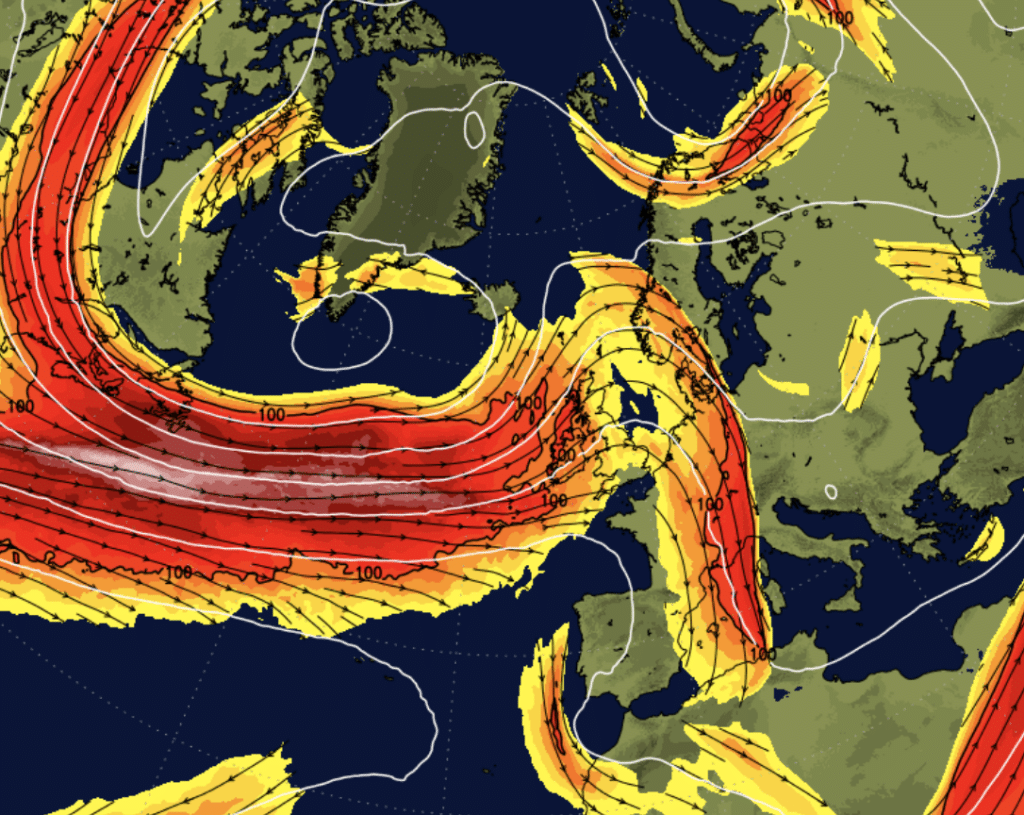Video shows inside commercial plane that accidentally flew faster than the speed of sound
- According to the US National Weather Service, the passenger jet was pushed to nearly 1,300 km/h, which is faster than the speed of sound
- The Atlantic jet stream usually has winds traveling at speeds close to 177 km/h (110 mph) but it’s known to intensify at times, particularly during winter months
- The footage is incredible to say the least
Published on Feb 21, 2024 at 3:06 PM (UTC+4)
by Amelia Jean Hershman-Jones
Last updated on Mar 01, 2024 at 1:40 PM (UTC+4)
Edited by
Alessandro Renesis
POV: you’re trying to watch a movie and relax on a transatlantic flight when the commercial plane accelerates and you’re suddenly flying faster than the speed of sound.
Nightmare fuel, but that’s what happened to the anxious passengers in this video.
And their terror is evident as screams and shouts were heard as jostled passengers clung to the seats.

READ MORE! Breathtaking one-of-a-kind photo emerges of Concorde breaking Mach 2 barrier
Freak winds in the Atlantic jet stream pushed passenger airplanes to supersonic speeds of over 1,300 km/h (800 mph) over the weekend.
And this video shared by Frankman on X shows what it was really like for passengers.
That’s faster than the speed of sound, meaning the commercial plane hit supersonic speeds without warning.
It’s also similar to the speeds reached by Concorde – Mach 2.04 (2,170 km/h; 1,350 mph) – the first and last commercial plane to break the sound barrier.

One of the commercial planes was a Virgin Atlantic flight from Washington to London.
According to the US National Weather Service, the passenger jet was pushed to nearly 1,300 km/h, which is faster than the speed of sound.
If you’re wondering how, apparently near record-breaking wind over the mid-Atlantic region pushed east-bound commercial plans to supersonic speeds.
“This evening’s weather balloon launch detected the 2nd strongest upper-level wind recorded in local history going back to the mid 20th century,” the National Weather Service Baltimore/Washington posted on X.
“Around 34,000-35,000ft, winds peaked around 230 knots (265mph!). For those flying eastbound in this jet, there will be quite a tailwind,” the weather service said.

Apparently, two other aircraft, including one from New Jersey’s Newark Airport to Lisbon, Portugal, reached speeds of 1,344 km/h (835 mph).
But while the planes were pushed to speeds higher than that of sound, they didn’t break the sound barrier.
The reason – they weren’t traveling faster than sound relative to the air around them in the jet stream.
The Atlantic jet stream is a fast and narrow current of air flowing from west to east and encircling the globe.
It’s widely used by planes traveling east from North America to cut down on their travel times and fuel use.
The Atlantic jet stream usually has winds traveling at speeds close to 177 km/h (110 mph) but it’s known to intensify at times, particularly during winter months.
Such jetstream speeds typically help flights traveling toward Europe reach their destinations faster.
However, they’ve been known to cause issues for planes moving in the opposite direction due to turbulence, increasing travel times and fuel consumption.
Now, a new fleet of supersonic jets is making its way to the runways of the future.
NASA’s X-59 will break the sound barrier silently while Stargazer will open up travel from New York to London in just one hour.
DISCOVER SBX CARS: The global premium car auction platform powered by Supercar Blondie
All Supercar Blondie contributors undergo editorial review and fact-checking to ensure accuracy and authority in automotive journalism. After gaining her BA Hons in French and English at the University of Nottingham, Amelia embarked on a vocational diploma from the National Council for the Training of Journalists (NCTJ). This led to numerous opportunities, from interning at Vogue to being on the small team that launched Women’s Health magazine in the UK, which was named the PPA Consumer magazine of the year for three years running. As Health, Beauty and Fitness editor, Amelia personally received a Johnson & Johnson Award and was shortlisted for both PPA and BSME titles. Since then, Amelia has created content for numerous titles and brands, including the Telegraph, 111 Skin, Waitrose, Red magazine, Stylist, and Elle, as well as being Head of Content at Vitality and Editor in Chief at INLondon magazine. “My superpower is translating technical jargon about the mechanical workings of a supercar into a relatable story you’ll want to share with your friends after you’ve read it.” After joining the SB Media family as a senior journalist in September of 2023, Amelia’s role has evolved to see her heading up the SEO output of the editorial team. From researching the most ‘Google-able’ key terms to producing evergreen content - it’s been a time of hard work, growth, and success for the editorial team and the Supercar Blondie website. “I like to think of myself as a ‘method journalist’. In other words: I live and breathe whatever I am writing about. When writing about fitness, I trained as a personal trainer, and as a beauty editor, I completed an ‘expert’ in scent diploma with the Fragrance Foundation. “During my tenure at Supercar Blondie, however, I did something I never thought possible: I passed my driving test at the age of 36. One day I’d love to train as a mechanic to better understand what happens under the hood, too. “My sweet spot is providing readers with a ‘takeaway’ (read: something new they didn’t know before) after reading every one of my stories. While I don’t claim to be an expert in the automotive world, I know the experts and bodies in the field to rely on to provide our readers with an informative and thought-provoking story every time they visit the site.”




